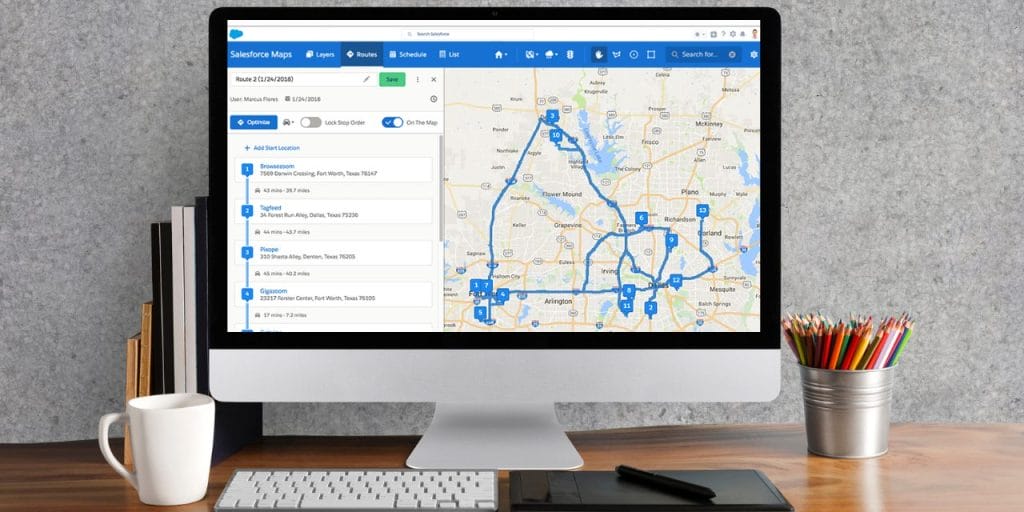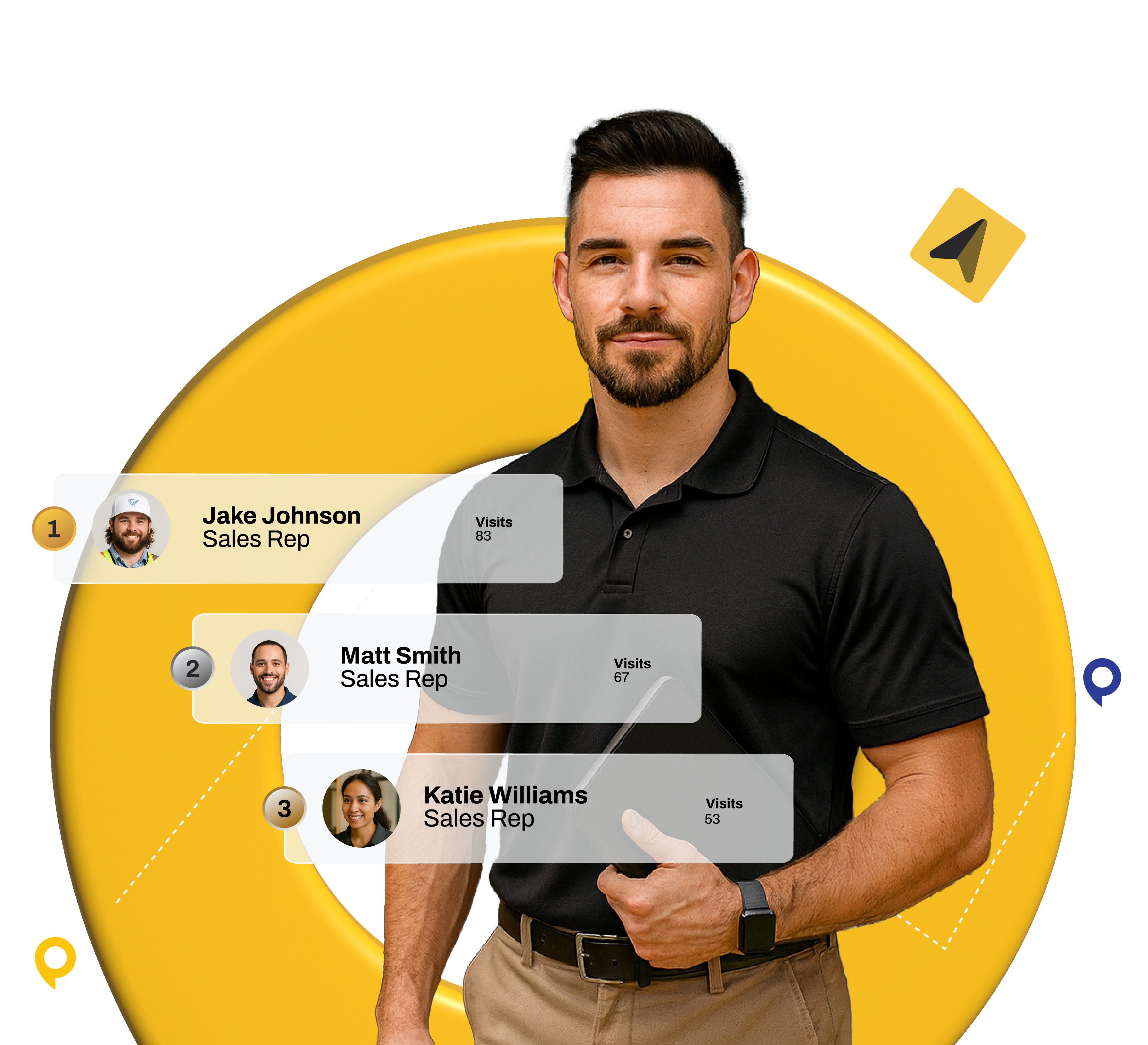Salesforce Maps costs up to $125 per user per month, yet most field teams use less than half its features. Add in a 3-6 month implementation timeline and a desktop-first interface that feels clunky on mobile, and it’s no surprise sales leaders are looking for alternatives that actually match how field reps work.
This guide breaks down 9 Salesforce Maps alternatives built for real field sales workflows—mobile-first platforms that cut route planning time, simplify territory management, and help reps spend more time selling, not wrestling with software.
Quick Comparison: Top Salesforce Maps Alternatives
| Platform | Best For | Starting Price | Mobile-First | Key Strength |
|---|---|---|---|---|
| SPOTIO | Field sales teams | Custom pricing | Yes | Complete field sales platform with AI |
| Geopointe | Salesforce integration | $75 per user per month, billed annually | Partial | Native Salesforce data sync |
| Maptitude | Desktop GIS mapping | $695 one-time | No | Comprehensive desktop mapping suite |
| ArcGIS | Enterprise GIS analysis | Custom pricing | No | Advanced spatial analysis capabilities |
| Badger Maps | Basic route optimization | $58 per user per month for small teams, $95 per user per month for enterprise | Yes | Simple multi-stop route planning |
| eSpatial | Sales analysis | $1,495 per year | Yes | Data visualization and heat mapping |
| Mapbox | Developer customization | Pay-as-you-go | Custom | Flexible API and custom map styling |
| SalesRabbit | Door-to-door teams | $59 per user per month with many features priced as add-ons | Yes | Territory assignment for D2D |
| Maptive | Custom mapping | $1,250 per year for single user | Yes | Interactive custom map creation |
Salesforce Maps G2 Rating: 4.3/5
Why Field Sales Teams Look Beyond Salesforce Maps
Salesforce Maps works for enterprise teams with deep pockets and dedicated admins. For everyone else, three pain points stand out.
High Cost with Limited Features
Salesforce Maps pricing starts at $75 per user per month for the basic version and jumps to $125 per user per month for Maps Advanced with essential features like advanced routing and territory optimization. Field teams with 20+ reps face annual software costs exceeding $30,000—before factoring in implementation fees and ongoing admin overhead.
Complex Setup and Adoption Challenges
Implementation timelines stretch 3-6 months for most teams, requiring dedicated Salesforce admin support and extensive rep training. Compare that to modern field sales platforms where teams go live in days, not quarters.
Desktop-First Design in a Mobile-First World
Salesforce Maps was built when field reps worked from laptops. Today’s reps need tools that work seamlessly on smartphones—one-tap logging, offline access, and interfaces designed for thumbs, not mouse clicks. Field sales professionals spend 55% of their day actively selling, leaving little patience for clunky desktop software that slows them down.
Key Features Every Salesforce Maps Alternative Should Include
Not all mapping software serves field sales teams equally. Here’s what actually matters when reps are in the field.
- Route optimization with multi-stop planning gets reps to more accounts per day. The best platforms calculate optimal routes based on appointment times, traffic patterns, and territory priorities—cutting drive time by 20-30%.
- Mobile-first design with offline functionality ensures reps can work anywhere. Download territory data before heading out, log activities without cell service, and sync everything once you’re back online.
- Dynamic territory management and visualization helps managers balance workloads and spot coverage gaps fast. Color-coded maps show account distribution, revenue potential, and rep assignments at a glance.
- Real-time lead generation and prospect discovery turns maps into prospecting tools. Filter businesses by industry, size, and location, then add qualified prospects to your pipeline with one tap.
- Native CRM integrations beyond Salesforce matter. Teams using HubSpot, Pipedrive, or other platforms need seamless, bi-directional data sync—not Zapier workarounds with delayed updates.
- Automated activity logging with location verification eliminates manual data entry. Log calls, demos, and site visits in seconds while GPS coordinates prove field time compliance.
- Performance dashboards and analytics show what’s working. Track activities per rep, conversion rates by territory, and pipeline progress without building custom reports.
- One-tap actions and streamlined workflows respect reps’ time. Check in at accounts, update deal stages, and trigger follow-up sequences without switching between three different apps.
Top 9 Salesforce Maps Alternatives for 2025
We evaluated these platforms based on five criteria: mobile functionality, ease of implementation, pricing transparency, CRM integration depth, and real-world customer reviews from field sales teams.
1. SPOTIO — Best for Field Sales Teams
SPOTIO is purpose-built for outside sales teams who need more than just route planning—it’s a complete field sales engagement solution that combines territory management, prospect discovery, and automated workflows in one mobile-first interface.
Key Capabilities:
- Custom territory mapping & management: Create balanced territories with visual tools and automatic rep assignment—the #1 rated SPOTIO feature (89% user satisfaction
- Built-in prospect discovery: Target qualified residential prospects using SPOTIO’s Lead Machine with 15+ demographic filters including home value, household income, and property type. For B2B prospecting, leverage Google Places integration to find and filter businesses in your territory, then add them to your pipeline in seconds.
- One-tap activity logging: Log calls, demos, and follow-ups with single-tap actions while data syncs seamlessly to your CRM—no manual data entry
- Location-verified activities:GPS coordinates attach to every logged activity, proving field time without invasive real-time tracking
- Efficient route planning: Calculate optimal multi-stop routes in SPOTIO, then handoff to Google Maps, Apple Maps or Waze for real-time traffic
- Real-time bi-directional CRM sync: Seamless integration with Salesforce, HubSpot, and other major CRMs ensures data stays current
- Download My Day offline functionality: Pre-download specific territory data and work offline for up to 24 hours with full functionality
Pricing: Custom pricing based on team size and features. Free trial available.
Field teams using SPOTIO report spending less time on admin tasks and more time in front of customers. The platform goes beyond basic mapping to solve the full field sales workflow—from prospecting to deal close.
Ready to see how SPOTIO stacks up? Book a demo and get a personalized walkthrough tailored to your team’s workflow.
2. Geopointe — Best for Deep Salesforce Integration
G2 Rating: 4.3/5
Geopointe runs natively inside Salesforce, making it the natural choice for teams deeply embedded in the Salesforce ecosystem who want mapping without leaving their CRM.
Key Capabilities:
- Native Salesforce integration: Runs entirely within Salesforce interface with no separate login or platform switching
- Real-time data visualization: Maps automatically update as Salesforce records change
- Route optimization: Plan daily routes directly from Salesforce account and lead data
- Territory management: Create and modify territories with visual drawing tools and assignment rules
- Mass updates and data management: Select multiple records on the map to update fields in bulk
Pricing: Starts at $75 per user per month for annual subscriptions. Enterprise plans with volume discounts available. Free trial offered.
Geopointe makes sense for Salesforce-committed teams who value keeping their tech stack consolidated, though teams using other CRMs should look elsewhere. It lacks the comprehensive field sales automation features found in SPOTIO.
3. Maptitude — Best for Desktop GIS and Mapping
G2 Rating: 4.7/5
Maptitude delivers professional-grade GIS and mapping capabilities at a desktop software price point. This platform suits sales ops teams who build territory models and analyze market coverage from the office.
Key Capabilities:
- Comprehensive mapping tools: Create custom maps with unlimited layers, data visualization, and styling options
- Territory alignment and balancing: Use advanced algorithms to create balanced territories based on revenue, account count, or geographic factors
- Demographic and business data: Access built-in demographic datasets and business location databases
- Drive time analysis: Calculate realistic drive times between accounts factoring in road networks and traffic patterns
- Heat mapping and density analysis: Visualize sales performance, customer concentration, and market penetration
Pricing: One-time purchase of $695 for desktop software. No monthly subscription fees.
Maptitude’s desktop-first design limits field utility, making it unsuitable for reps who need mobile access. Sales ops teams appreciate the powerful analysis tools for territory planning, but field reps need mobile-first platforms like SPOTIO.
4. Esri ArcGIS — Best for Comprehensive GIS and Spatial Analysis
G2 Rating: 4.5/5
ArcGIS from Esri is the enterprise standard for geographic information systems. It offers unmatched spatial analysis capabilities but requires GIS expertise and significant investment.
Key Capabilities:
- Enterprise-grade spatial analysis: Advanced analytics including predictive modeling, geocoding, and spatial statistics
- Location intelligence platform: Combine sales data with demographic, economic, and competitive intelligence
- 3D visualization and modeling: Create sophisticated territory models with elevation and building data
- Real-time data integration: Connect live data feeds for dynamic mapping and analysis
- Industry-specific solutions: Pre-built templates for retail, healthcare, logistics, and other verticals
Pricing: Custom, contact for quote. Enterprise pricing available with advanced features. Free trial available through ArcGIS Online.
ArcGIS delivers exceptional power for enterprise organizations with dedicated GIS teams and large budgets, but smaller field sales operations typically find it overkill for day-to-day territory management. The learning curve is steep and implementation requires specialized expertise.
5. Badger Maps — Known for Basic Route Optimization
G2 Rating: 4.7/5
Badger Maps focuses on route optimization for field reps who manage regular customer visits. The platform handles basic routing but lacks the comprehensive field sales capabilities teams need as they scale.
Key Capabilities:
- Route optimization: Plan routes with multiple stops based on appointment windows and traffic
- Check-in functionality: Track which accounts reps visit with location-verified check-ins
- CRM integration: Connects with Salesforce and HubSpot to visualize CRM data on maps
- Lasso tool: Select multiple accounts by drawing on the map to assign territories
- Mobile app: iOS and Android apps for field work
Pricing: Starts at $58 per user per month (annual billing). Business plan at $95/month adds advanced features. Free 7-day trial available.
Badger Maps works for teams focused on route optimization. However, it lacks SPOTIO’s depth in prospect discovery, automated workflows, AI-powered sales enablement, and comprehensive activity tracking. Teams needing more than basic routing—including lead generation, sales content management, automated follow-ups, or performance analytics—quickly outgrow Badger Maps and require a complete field sales platform.
6. eSpatial — Best for Sales Analysis
G2 Rating: 4.3/5
eSpatial emphasizes data visualization and sales analysis, helping teams understand territory performance and market coverage through interactive maps.
Key Capabilities:
- Advanced data visualization: Create heat maps, cluster maps, and other visual representations of sales data
- Territory optimization: Design balanced territories using revenue, customer count, and travel time metrics
- Sales performance analysis: Overlay sales data on maps to identify high-performing and underperforming regions
- Route planning: Build optimized routes for field visits with multiple stops
- Custom data layers: Import spreadsheets, CRM exports, and external datasets for mapping
Pricing: Individual plan starts at $1,495 per year (single user). Team plans at $2,995/year for 5 users. Territory plan at $7,995/year adds advanced features. Free trial available.
eSpatial serves sales ops and management teams who prioritize analysis and territory design over day-to-day field rep workflows. It lacks the mobile-first design and field automation features working reps need daily.
7. Mapbox — Best for Developer Tools and API
G2 Rating: 4.3/5
Mapbox provides the mapping infrastructure and APIs that power custom applications. It’s designed for companies building proprietary field sales tools, not teams seeking ready-to-use software.
Key Capabilities:
- Flexible mapping APIs: Build custom mapping interfaces with full control over styling, data layers, and interactions
- Global coverage: High-quality map data covering worldwide locations with regular updates
- Custom data visualization: Create unique map styles and data overlays tailored to specific use cases
- Geocoding and search: Convert addresses to coordinates and build location search functionality
- Navigation SDKs: Integrate turn-by-turn navigation into custom applications
Pricing: Pay-as-you-go based on API requests and active users. Free tier includes 50,000 requests per month. Costs scale significantly with usage.
Mapbox requires developer resources to build and maintain custom solutions. Teams without in-house development capabilities should choose ready-to-deploy platforms like SPOTIO instead.
8. SalesRabbit — Designed for Door-to-Door Territory Management
G2 Rating: 4.5/5
SalesRabbit targets door-to-door and residential sales teams with tools for territory assignment, lead management, and rep tracking.
Key Capabilities:
- Territory drawing and assignment: Create custom territories and assign reps with visual mapping tools
- Pin mapping: Mark potential customers on maps and track interaction history
- Check-in tracking: Reps log activities with location stamps for accountability
- Lead management: Upload prospect lists and organize them by territory
- Mobile app: iOS and Android apps designed for door-to-door workflows
Pricing: Team plan starts at $59 per user per month (no contract). Pro plan at $49/month (annual billing) adds integrations and advanced features. Enterprise plans with custom pricing available. Free trial offered.
SalesRabbit fits door-to-door and residential sales models but lacks the B2B-focused features, CRM depth, sales intelligence tools, and AI capabilities that enterprise field teams typically need. Teams selling complex B2B products or services require more sophisticated platforms.
9. Maptive — Best for Custom Mapping
G2 Rating: 4.7/5
Maptive offers cloud-based mapping tools for creating custom, interactive maps from spreadsheet data—useful for teams building territory models and sales presentations.
Key Capabilities:
- Spreadsheet to map conversion: Upload Excel or CSV files to automatically create mapped visualizations
- Custom map styling: Control colors, icons, boundaries, and visual elements to match brand standards
- Heat maps: Visualize customer concentration, sales performance, and market coverage
- Radius and proximity tools: Draw circles around locations to analyze coverage areas
- Territory boundaries: Create custom regions and color-code by performance or assignment
Pricing: Pro plan at $1,250 per year (single user). Team plan at $2,500/year for 5 users. Enterprise plans with custom pricing for 10+ users. 45-day pass available for $250. Free trial offered.
Maptive works for creating polished map visualizations and presentations but lacks the CRM integration, field workflow automation, and mobile-first design that working reps need daily.
How to Choose the Right Alternative for Your Team
The best Salesforce Maps alternative depends on your specific team structure, sales model, and technical requirements. Here’s how to narrow your options.
Assess Your Team’s Primary Workflow
Door-to-door and residential teams need territory assignment tools and mobile check-in capabilities. SalesRabbit handles basic D2D workflows, though SPOTIO provides more comprehensive features for teams that also need prospecting and automation.
B2B field sales teams with longer sales cycles benefit from platforms with robust CRM integration, activity tracking, and deal management. SPOTIO delivers the complete workflow from prospecting to close, while Badger Maps and Geopointe cover only narrow slices of the sales process.
Sales ops and planning teams who build territories and analyze market coverage should prioritize desktop mapping power. Maptitude, ArcGIS, and eSpatial deliver advanced analysis tools but don’t support field reps directly.
Evaluate Mobile vs. Desktop Priorities
Field reps working from smartphones need mobile-first platforms with offline capabilities, one-tap actions, and interfaces designed for small screens. SPOTIO prioritizes mobile experience with Download My Day offline functionality and streamlined workflows built for thumbs, not mouse clicks.
Teams with office-based territory planners can leverage desktop-focused tools like Maptitude and ArcGIS that offer advanced analysis features but limited mobile functionality.
Calculate Total Cost of Ownership
Look beyond base subscription prices to understand true costs.
All-inclusive pricing (SPOTIO) bundles features in tiered plans with predictable monthly costs and includes training, support, and regular updates.
Feature-limited basic plans (Badger Maps, SalesRabbit) advertise low entry prices but require upgrades to access essential capabilities, driving total costs higher than they initially appear.
Usage-based pricing (Mapbox) starts cheap but scales unpredictably as your team grows and API requests increase.
One-time purchase (Maptitude) eliminates recurring fees but requires upfront capital and doesn’t include cloud features, mobile apps, or ongoing updates.
Factor in implementation costs, training time, and ongoing admin overhead when comparing options.
When Basic Route Planning Isn’t Enough
Many teams start with basic route optimization tools like Badger Maps but quickly hit limitations as they scale. If your reps need more than just efficient driving routes—including prospect discovery, automated follow-ups, sales content management, AI assistance, or comprehensive analytics—basic routing tools leave significant gaps.
SPOTIO covers the complete field sales workflow, not just the commute between accounts. Teams that outgrow single-feature tools typically consolidate to comprehensive platforms that handle territory planning, prospecting, engagement, activity tracking, and performance management in one system.
Test Integration Capabilities
Verify that your chosen platform integrates with your existing tech stack.
Native CRM integrations (Salesforce, HubSpot) offer real-time, bi-directional sync with minimal configuration. SPOTIO and Geopointe provide native connections to major CRMs with seamless data flow.
Zapier-based integrations work for connecting to less common platforms but introduce sync delays and require Zap configuration maintenance.
API access (Mapbox) allows custom integrations but requires developer resources to build and maintain.
Verify Offline Functionality
Field reps often work in areas with spotty cell coverage. Platforms with true offline capabilities let reps download territory data, log activities, and access account information without internet connectivity.
SPOTIO’s Download My Day feature pre-downloads specific territories for 24-hour offline use with full functionality. Badger Maps offers limited offline routing. Desktop-first platforms like Maptitude and ArcGIS typically require constant connectivity.
Frequently Asked Questions
What is the best alternative to Salesforce Maps for field sales teams?
SPOTIO stands out as the best Salesforce Maps alternative for most field sales teams because it combines territory management, route planning, prospect discovery, and automated workflows in one mobile-first platform. Teams go live in days instead of months, and the location-verified activity tracking provides accountability without invasive real-time GPS monitoring. Badger Maps serves teams needing only basic route optimization, while Geopointe works best for organizations deeply committed to staying within the Salesforce ecosystem exclusively.
How much does Salesforce Maps cost compared to alternatives?
Salesforce Maps pricing ranges from $75 to $125 per user per month depending on whether you choose the basic or advanced version, putting annual costs for a 20-person team at $18,000-$30,000. Alternatives like Badger Maps start at $49/month and SalesRabbit at $39/month, though these lower-priced options require additional tools to cover the full field sales workflow. Geopointe starts at $55/month. SPOTIO uses custom pricing based on team size and features, typically delivering better total cost of ownership than assembling multiple point solutions. Desktop solutions like Maptitude offer one-time purchases around $695 but lack mobile and cloud capabilities.
Do these alternatives integrate with CRMs besides Salesforce?
Yes, most modern field sales platforms integrate with multiple CRMs. SPOTIO offers native, real-time bi-directional sync with Salesforce, HubSpot, Pipedrive, and other major platforms. Badger Maps connects to Salesforce, HubSpot, and Zoho. Geopointe runs exclusively within Salesforce and doesn’t support other CRMs. Platforms without native integrations typically offer Zapier connections, though these introduce sync delays and reliability issues. Verify that your chosen platform supports your specific CRM with the integration depth your team needs.
Which platform works best for small field sales teams?
Small teams (5-15 reps) benefit from platforms with fast implementation, minimal admin overhead, and transparent pricing. SPOTIO provides comprehensive field sales functionality with training and support included, allowing small teams to punch above their weight. Badger Maps offers basic routing starting at $49/month with quick setup but limited functionality beyond route planning. SalesRabbit works for door-to-door teams at $39/month. Avoid enterprise platforms like ArcGIS that require dedicated GIS expertise and significant investment unless you have specific advanced spatial analysis needs that justify the complexity.
Can I use these tools offline without internet connectivity?
Offline capabilities vary significantly between platforms. SPOTIO’s Download My Day feature lets reps pre-download territory data and work fully offline for 24 hours, logging activities and accessing account information without cell service. Badger Maps offers limited offline routing and account data access but requires connectivity for many features. Desktop platforms like Maptitude and ArcGIS typically require internet connectivity for full functionality. Cloud-based tools like Maptive and eSpatial need active internet connections. Verify offline functionality during trials if your reps work in areas with spotty coverage—this feature alone can make or break field productivity.
Make the Switch to SPOTIO
Salesforce Maps works for enterprise teams with unlimited budgets and dedicated admins. Everyone else needs tools built for how field sales actually works—mobile-first, fast to implement, and designed by people who understand the daily grind of outside sales.
SPOTIO combines territory management, route planning, prospect discovery, and activity tracking in one platform that reps actually use. Field teams go live in days, not months, and spend less time fighting software and more time closing deals.
See SPOTIO in action. Book a demo and get a personalized walkthrough showing exactly how SPOTIO fits your team’s workflow.




